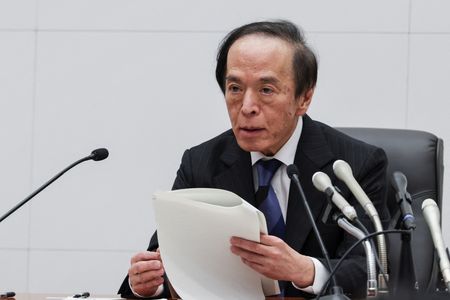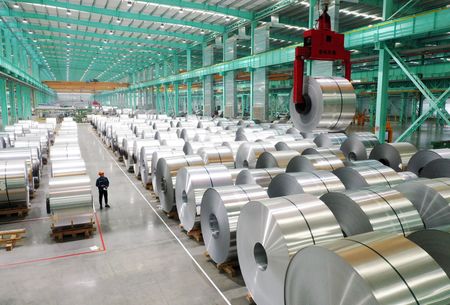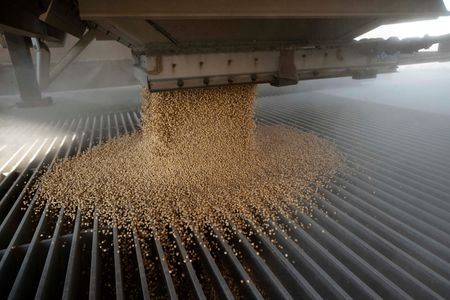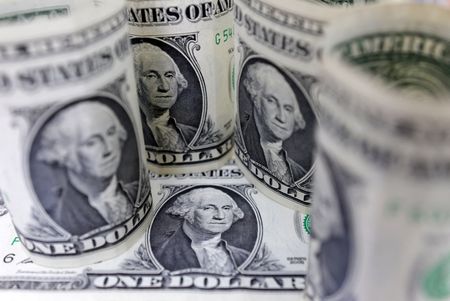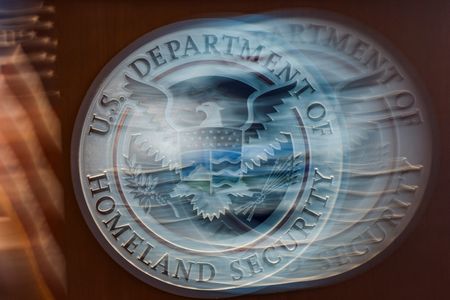(Reuters) -The Bank of Japan kept interest rates steady and cut its growth forecasts on Thursday, as uncertainty surrounding U.S. tariffs clouds the outlook for the world’s fourth-largest economy.
But the central bank projected inflation would stay roughly on course to hit its 2% target in the coming years, a sign that risks from U.S. tariffs might only delay, not derail, its rate hike plans.
Following are excerpts from BOJ Governor Kazuo Ueda’s comments at his post-meeting news conference, which was conducted in Japanese, as translated by Reuters:
UNCERTAINTY AROUND US TARIFFS
“Since the U.S. announcement of ‘reciprocal’ tariffs in early April, uncertainty surrounding each country’s trade policy is extremely high. There are various views on the outlook. But we based our forecasts on the assumption that there will be some progress in trade negotiations among entities, and that there will be no big disruption in global supply chains. Having said that, uncertainty regarding our baseline scenario is higher than in the past.”
TARIFF IMPACT ON JAPAN’S ECONOMY
“Recent developments surrounding tariffs will weigh on Japan’s economy by slowing global growth, hurting corporate profits, and prodding households and companies to hold off on spending due to heightening uncertainties. But we expect such downward pressure to recede thereafter, as overseas economies resume a moderate recovery.”
TARIFF IMPACT ON PRICES
“As for the impact on prices, underlying inflation will stagnate for some time, before heightening again.”
REAL INTEREST RATES
“Japan’s real interest rates remain very low, so by maintaining an accommodative monetary environment, we can firmly support Japan’s economic activity. But uncertainty regarding the tariff impact is very high, so we will scrutinise without pre-conception whether our economic and price forecasts will materialise.”
INFLATION AND WAGE GROWTH
“We downgraded our growth forecasts for fiscal 2025 and fiscal 2026 due to the impact of higher tariffs. As such, we’ll enter a period in which both inflation and wage growth will likely slow somewhat. But we expect a positive cycle of rising wages and inflation to continue due to a severe labour shortage.”
INFLATION TARGET
“The timing (for inflation to converge to our target) will be pushed back somewhat. It’s hard to judge now when we can see the likelihood of our scenario being achieved because we will enter a period of stagnation in inflation. As such, we would like to take a flexible approach in our policy response.”
“Unfortunately, the likelihood of our baseline scenario being achieved is no longer very high. Depending on developments surrounding tariffs, our baseline scenario itself could change. That could affect our monetary policy decisions.”
“We could see inflation overshoot our forecast … It’s hard to say now how we could respond if inflation overshoots and growth undershoots. That will depend on the degree of overshoot in inflation, and that of undershoot in growth.”
INFLATION AND RATE HIKE TIMING
“The timing for underlying inflation to converge toward 2% has been pushed back somewhat. But that doesn’t mean the timing of further rate hikes will automatically be delayed by the same margin.”
MAINTAINING MONETARY SUPPORT
“Our view has been that underlying inflation is accelerating but still below 2%, and there was some distance to achieving 2%. That’s why we had been maintaining monetary support, albeit adjusting the degree of it. If underlying inflation could have accelerated sharply, we might have been behind the curve. But underlying inflation has accelerated slowly, which shows we are not behind the curve. Looking ahead, we see the chance of underlying inflation slowing. As such, we decided that we can maintain the degree of monetary support at least at this policy meeting.”
MAINTAINING RATE-HIKE STANCE
“Although we downgraded our forecasts, we still expect underlying inflation to converge toward 2% during the three-year projection period of our quarterly report.”
“We won’t try to forcefully raise interest rates when underlying inflation is stalling. But if we see prospects of inflation accelerating toward 2%, then we could act.”
CONSUMPTION
“We’re seeing surging food prices affecting prices of processed food, which is affecting spending for some goods. But consumption overall is rising as a trend. There’s uncertainty on winter bonus payments and next year’s wage negotiations, but this year’s wage talks have resulted in solid results. We expect food inflation to moderate ahead, so we expect real wages will move in a good direction and support consumption.”
FOOD PRICES AND REAL WAGES
“What didn’t quite work as we expected was that food prices rose significantly since the middle of last year. That kept real wages from rising much, even when nominal pay rose. Another unexpected thing was that while rising wages pushed up goods prices, they didn’t push up services inflation that much.”
IMPACT OF TRUMP’S TARIFFS ON TERMINAL RATES
“That depends on how Japan’s natural rate of interest moves. It’s hard to say that there would be a direct, immediate impact. If Trump’s tariffs continue for a long time, that could affect the distribution of resources and could theoretically push down the natural rate, but it’s hard to conclude as such yet.”
(Reporting by Leika Kihara; Editing by Rashmi Aich)

